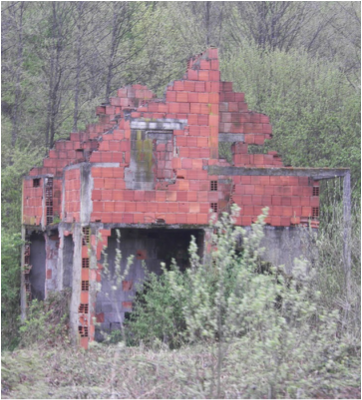
There are many, many reasons to travel by train in Germany and Europe. It is cheaper, more comfortable, and sometimes more practical than driving and finding a place to park. That said, there are other moments which arise that really hit home. Here is one such example.
I was travelling in Germany with a group of my students in June of 2014. We had just finished three days in the Berlin-Potsdam area and were now on our way to the Dresden area for four days. It was Sunday evening, and we had elected to take the regional trains (RegioBahn) rather than the speed trains (IC/ICE). It would give us a chance to relax and rest on a quieter trip after all the walking and fast-paced visiting of Germany’s capital. This was my first trip through the old areas of the DDR (East Germany), outside of the yearly rides to Berlin via Bremen. Occasionally we passed towns with mixed Prussian and Czech or Polish names, but the real thing was the amount of, as Joyce put it, “undeveloped” land. Definitely the population density was much lower in this part of Germany than elsewhere.
Somewhere along the route between the towns and station of Grossenhain-Cottbus and Priestewitz, our train had to halt and allow a transport train to come through. We stopped a mile or so from Priestewitz, and one of my students, Jacob Anderson, called we over to where he was sitting and pointed out his window and asked “what is that?” He was pointing to an old farmstead… 5 buildings- a house, a barn, two tool sheds, and a garage/mechanic shop. All were overgrown and severely damaged. “Is that from the war,” he asked. It was clear that the place had been a family home destroyed during the Russian push to Berlin. It looked like a scene from the old classic war movies, but it was real. I confirmed his suspicions, and other students quickly came over as the train started to move again. The students remarked how it was amazing that 70 years after the war it was still there, neither re-built nor torn down. They expressed wonder and what had happened. It allowed me to explain how the family probably fled (or were killed) and no one came back.
My students were deeply touched by this frozen moment in time, and wondered about the family, its history, and if they survived, do they even know their old home is still there. We discussed the population shift to the West both during and after the war, and how these areas were completely depopulated. As we started to roll on, we saw land which was once cultivated but now returned to the wild. My wife Joyce was able to point out the former field lines and crop areas, so subtly different that other wild areas, and the students quickly seized on this knowledge. Long discussions and questions about the war in Germany and the struggles of East Germany ensued. The students spent the last hour of the ride to Dresden looking and hoping to find more poignant moments trapped in time.
Such events, I have learned over the years, occur much more often and more deeply on trains than travelling in a car or even a bus tour. In a car you focus on the destination and trivial moments of chat. On a bus, you are packed and cramped, and some even have video to watch. On a train, you can read a book, put on headphones, or even do a crossword puzzle book, but your eyes are always drawn out the window. There is something magnetic to the passing scenery that interrupts your attempts at distraction and take your eyes and thoughts to the world just beyond the glass. Add to that the ability to have a group discussion session all at once when a topic arises, and you understand just one of the reasons trains are so amazing to ride on.
I was travelling in Germany with a group of my students in June of 2014. We had just finished three days in the Berlin-Potsdam area and were now on our way to the Dresden area for four days. It was Sunday evening, and we had elected to take the regional trains (RegioBahn) rather than the speed trains (IC/ICE). It would give us a chance to relax and rest on a quieter trip after all the walking and fast-paced visiting of Germany’s capital. This was my first trip through the old areas of the DDR (East Germany), outside of the yearly rides to Berlin via Bremen. Occasionally we passed towns with mixed Prussian and Czech or Polish names, but the real thing was the amount of, as Joyce put it, “undeveloped” land. Definitely the population density was much lower in this part of Germany than elsewhere.
Somewhere along the route between the towns and station of Grossenhain-Cottbus and Priestewitz, our train had to halt and allow a transport train to come through. We stopped a mile or so from Priestewitz, and one of my students, Jacob Anderson, called we over to where he was sitting and pointed out his window and asked “what is that?” He was pointing to an old farmstead… 5 buildings- a house, a barn, two tool sheds, and a garage/mechanic shop. All were overgrown and severely damaged. “Is that from the war,” he asked. It was clear that the place had been a family home destroyed during the Russian push to Berlin. It looked like a scene from the old classic war movies, but it was real. I confirmed his suspicions, and other students quickly came over as the train started to move again. The students remarked how it was amazing that 70 years after the war it was still there, neither re-built nor torn down. They expressed wonder and what had happened. It allowed me to explain how the family probably fled (or were killed) and no one came back.
My students were deeply touched by this frozen moment in time, and wondered about the family, its history, and if they survived, do they even know their old home is still there. We discussed the population shift to the West both during and after the war, and how these areas were completely depopulated. As we started to roll on, we saw land which was once cultivated but now returned to the wild. My wife Joyce was able to point out the former field lines and crop areas, so subtly different that other wild areas, and the students quickly seized on this knowledge. Long discussions and questions about the war in Germany and the struggles of East Germany ensued. The students spent the last hour of the ride to Dresden looking and hoping to find more poignant moments trapped in time.
Such events, I have learned over the years, occur much more often and more deeply on trains than travelling in a car or even a bus tour. In a car you focus on the destination and trivial moments of chat. On a bus, you are packed and cramped, and some even have video to watch. On a train, you can read a book, put on headphones, or even do a crossword puzzle book, but your eyes are always drawn out the window. There is something magnetic to the passing scenery that interrupts your attempts at distraction and take your eyes and thoughts to the world just beyond the glass. Add to that the ability to have a group discussion session all at once when a topic arises, and you understand just one of the reasons trains are so amazing to ride on.

 RSS Feed
RSS Feed